Disability Discrimination Act, 1992: Welfare Law Analysis Report
VerifiedAdded on 2022/08/13
|11
|2717
|14
Report
AI Summary
This report provides a comprehensive analysis of the Disability Discrimination Act, 1992, a crucial piece of welfare law in Australia. It begins by outlining the historical context and objectives of the Act, which aims to prevent discrimination against disabled individuals in various sectors, including education, employment, and service provision. The discussion delves into the Act's core principles, such as prohibiting direct and indirect discrimination, and explores its impact on ensuring equal opportunities and protecting the rights of people with disabilities. The report examines relevant case law, including Maguire vs. Sydney Organizing Committee for the Olympic Games and Quinlan vs. B&Q, to illustrate the application of the Act and its implications. Furthermore, the report addresses ethical considerations in disability research, emphasizing the importance of respecting the rights and dignity of research participants. It also highlights exceptions to the Act, such as situations where discrimination is not considered illegal. The conclusion emphasizes the significance of the Disability Discrimination Act, 1992, in promoting equality and reducing discrimination against individuals with disabilities.
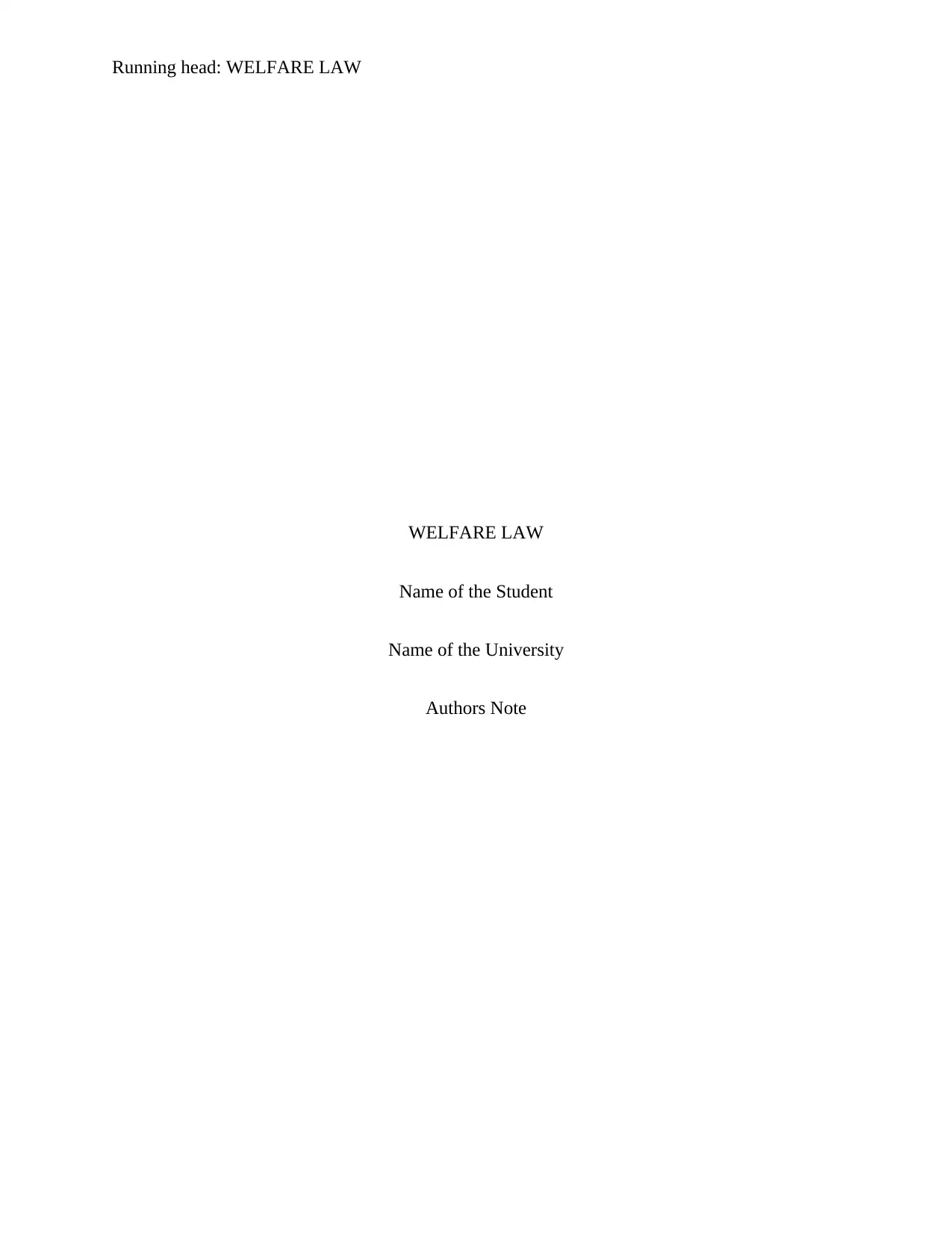
Running head: WELFARE LAW
WELFARE LAW
Name of the Student
Name of the University
Authors Note
WELFARE LAW
Name of the Student
Name of the University
Authors Note
Paraphrase This Document
Need a fresh take? Get an instant paraphrase of this document with our AI Paraphraser
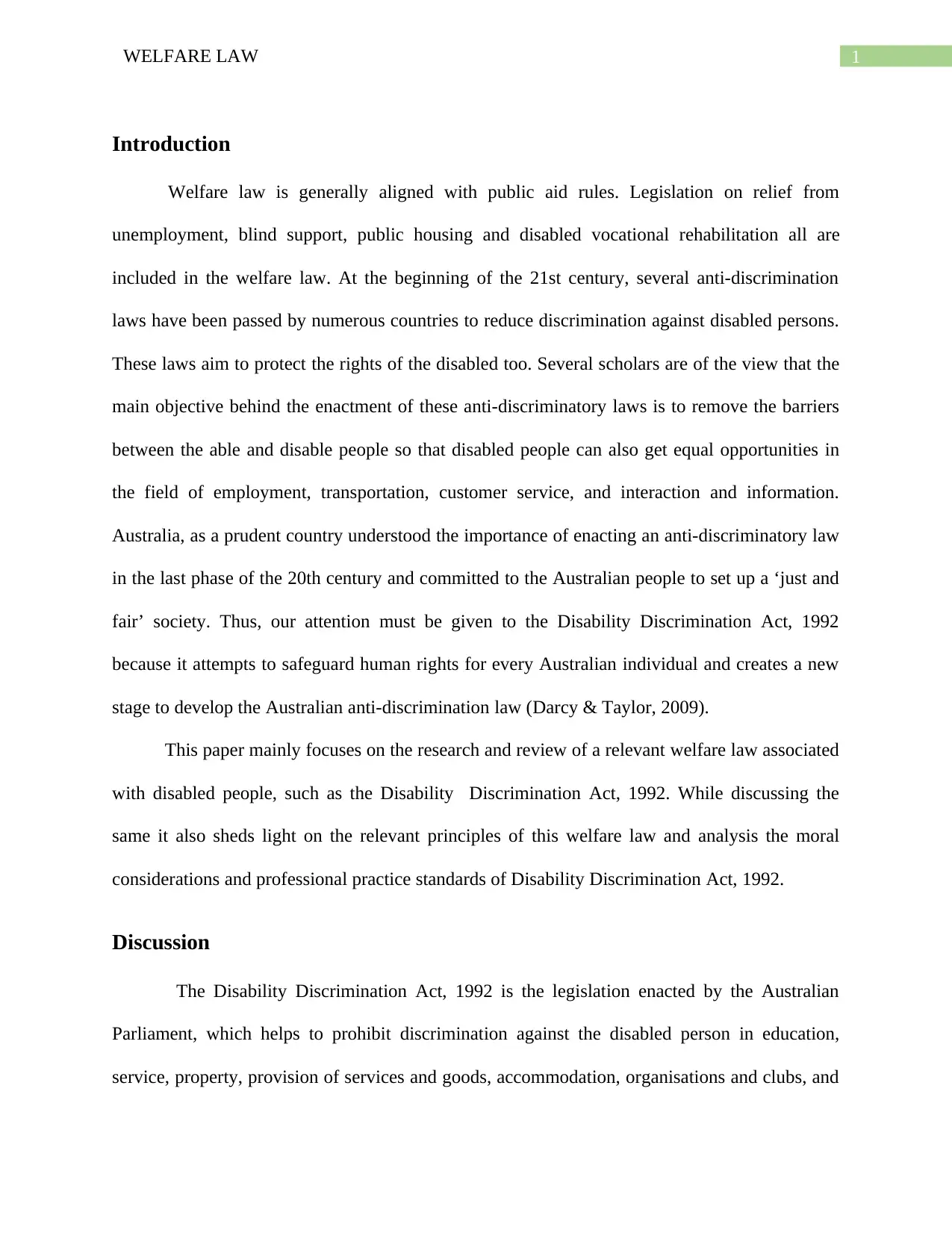
1WELFARE LAW
Introduction
Welfare law is generally aligned with public aid rules. Legislation on relief from
unemployment, blind support, public housing and disabled vocational rehabilitation all are
included in the welfare law. At the beginning of the 21st century, several anti-discrimination
laws have been passed by numerous countries to reduce discrimination against disabled persons.
These laws aim to protect the rights of the disabled too. Several scholars are of the view that the
main objective behind the enactment of these anti-discriminatory laws is to remove the barriers
between the able and disable people so that disabled people can also get equal opportunities in
the field of employment, transportation, customer service, and interaction and information.
Australia, as a prudent country understood the importance of enacting an anti-discriminatory law
in the last phase of the 20th century and committed to the Australian people to set up a ‘just and
fair’ society. Thus, our attention must be given to the Disability Discrimination Act, 1992
because it attempts to safeguard human rights for every Australian individual and creates a new
stage to develop the Australian anti-discrimination law (Darcy & Taylor, 2009).
This paper mainly focuses on the research and review of a relevant welfare law associated
with disabled people, such as the Disability Discrimination Act, 1992. While discussing the
same it also sheds light on the relevant principles of this welfare law and analysis the moral
considerations and professional practice standards of Disability Discrimination Act, 1992.
Discussion
The Disability Discrimination Act, 1992 is the legislation enacted by the Australian
Parliament, which helps to prohibit discrimination against the disabled person in education,
service, property, provision of services and goods, accommodation, organisations and clubs, and
Introduction
Welfare law is generally aligned with public aid rules. Legislation on relief from
unemployment, blind support, public housing and disabled vocational rehabilitation all are
included in the welfare law. At the beginning of the 21st century, several anti-discrimination
laws have been passed by numerous countries to reduce discrimination against disabled persons.
These laws aim to protect the rights of the disabled too. Several scholars are of the view that the
main objective behind the enactment of these anti-discriminatory laws is to remove the barriers
between the able and disable people so that disabled people can also get equal opportunities in
the field of employment, transportation, customer service, and interaction and information.
Australia, as a prudent country understood the importance of enacting an anti-discriminatory law
in the last phase of the 20th century and committed to the Australian people to set up a ‘just and
fair’ society. Thus, our attention must be given to the Disability Discrimination Act, 1992
because it attempts to safeguard human rights for every Australian individual and creates a new
stage to develop the Australian anti-discrimination law (Darcy & Taylor, 2009).
This paper mainly focuses on the research and review of a relevant welfare law associated
with disabled people, such as the Disability Discrimination Act, 1992. While discussing the
same it also sheds light on the relevant principles of this welfare law and analysis the moral
considerations and professional practice standards of Disability Discrimination Act, 1992.
Discussion
The Disability Discrimination Act, 1992 is the legislation enacted by the Australian
Parliament, which helps to prohibit discrimination against the disabled person in education,
service, property, provision of services and goods, accommodation, organisations and clubs, and
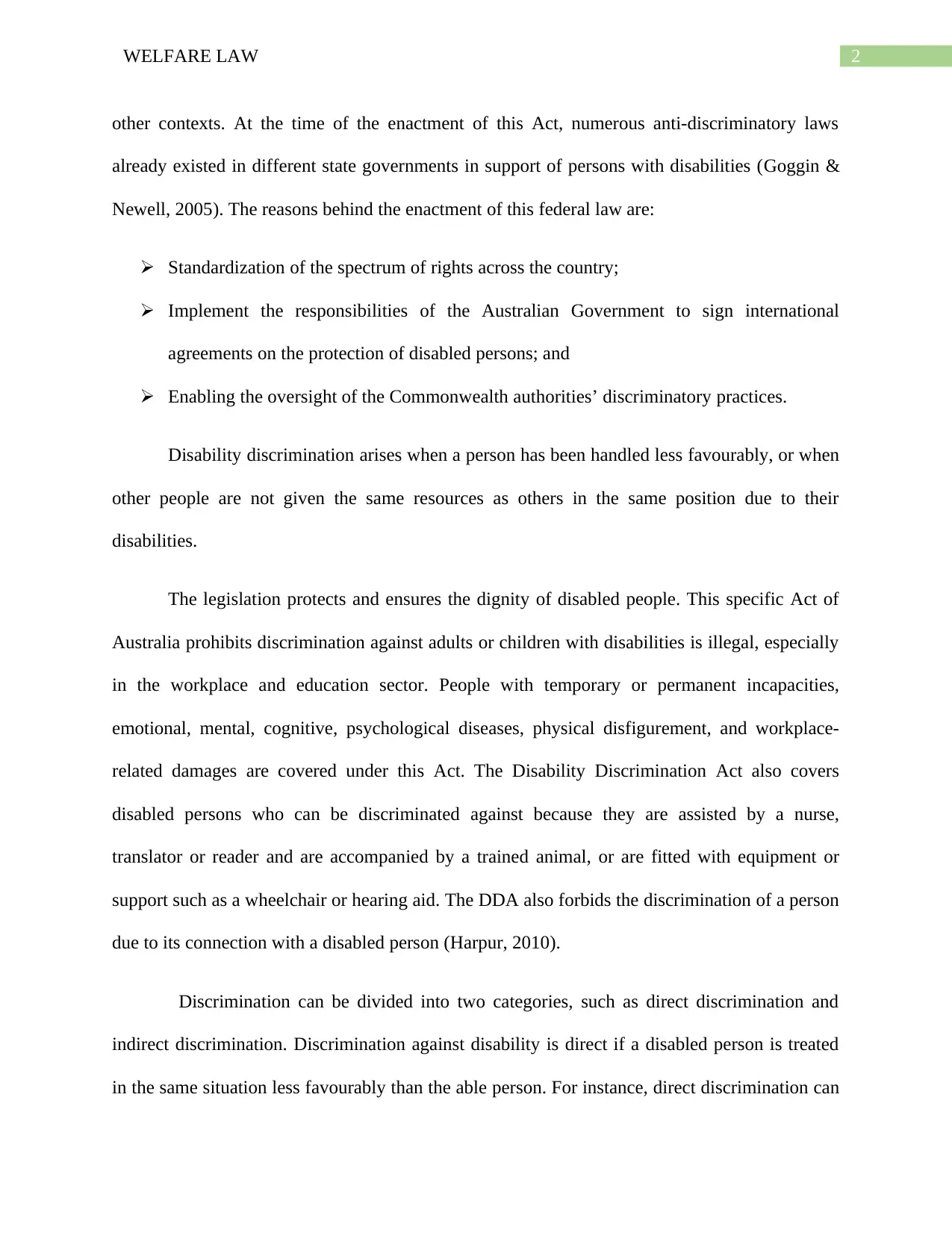
2WELFARE LAW
other contexts. At the time of the enactment of this Act, numerous anti-discriminatory laws
already existed in different state governments in support of persons with disabilities (Goggin &
Newell, 2005). The reasons behind the enactment of this federal law are:
Standardization of the spectrum of rights across the country;
Implement the responsibilities of the Australian Government to sign international
agreements on the protection of disabled persons; and
Enabling the oversight of the Commonwealth authorities’ discriminatory practices.
Disability discrimination arises when a person has been handled less favourably, or when
other people are not given the same resources as others in the same position due to their
disabilities.
The legislation protects and ensures the dignity of disabled people. This specific Act of
Australia prohibits discrimination against adults or children with disabilities is illegal, especially
in the workplace and education sector. People with temporary or permanent incapacities,
emotional, mental, cognitive, psychological diseases, physical disfigurement, and workplace-
related damages are covered under this Act. The Disability Discrimination Act also covers
disabled persons who can be discriminated against because they are assisted by a nurse,
translator or reader and are accompanied by a trained animal, or are fitted with equipment or
support such as a wheelchair or hearing aid. The DDA also forbids the discrimination of a person
due to its connection with a disabled person (Harpur, 2010).
Discrimination can be divided into two categories, such as direct discrimination and
indirect discrimination. Discrimination against disability is direct if a disabled person is treated
in the same situation less favourably than the able person. For instance, direct discrimination can
other contexts. At the time of the enactment of this Act, numerous anti-discriminatory laws
already existed in different state governments in support of persons with disabilities (Goggin &
Newell, 2005). The reasons behind the enactment of this federal law are:
Standardization of the spectrum of rights across the country;
Implement the responsibilities of the Australian Government to sign international
agreements on the protection of disabled persons; and
Enabling the oversight of the Commonwealth authorities’ discriminatory practices.
Disability discrimination arises when a person has been handled less favourably, or when
other people are not given the same resources as others in the same position due to their
disabilities.
The legislation protects and ensures the dignity of disabled people. This specific Act of
Australia prohibits discrimination against adults or children with disabilities is illegal, especially
in the workplace and education sector. People with temporary or permanent incapacities,
emotional, mental, cognitive, psychological diseases, physical disfigurement, and workplace-
related damages are covered under this Act. The Disability Discrimination Act also covers
disabled persons who can be discriminated against because they are assisted by a nurse,
translator or reader and are accompanied by a trained animal, or are fitted with equipment or
support such as a wheelchair or hearing aid. The DDA also forbids the discrimination of a person
due to its connection with a disabled person (Harpur, 2010).
Discrimination can be divided into two categories, such as direct discrimination and
indirect discrimination. Discrimination against disability is direct if a disabled person is treated
in the same situation less favourably than the able person. For instance, direct discrimination can
⊘ This is a preview!⊘
Do you want full access?
Subscribe today to unlock all pages.

Trusted by 1+ million students worldwide
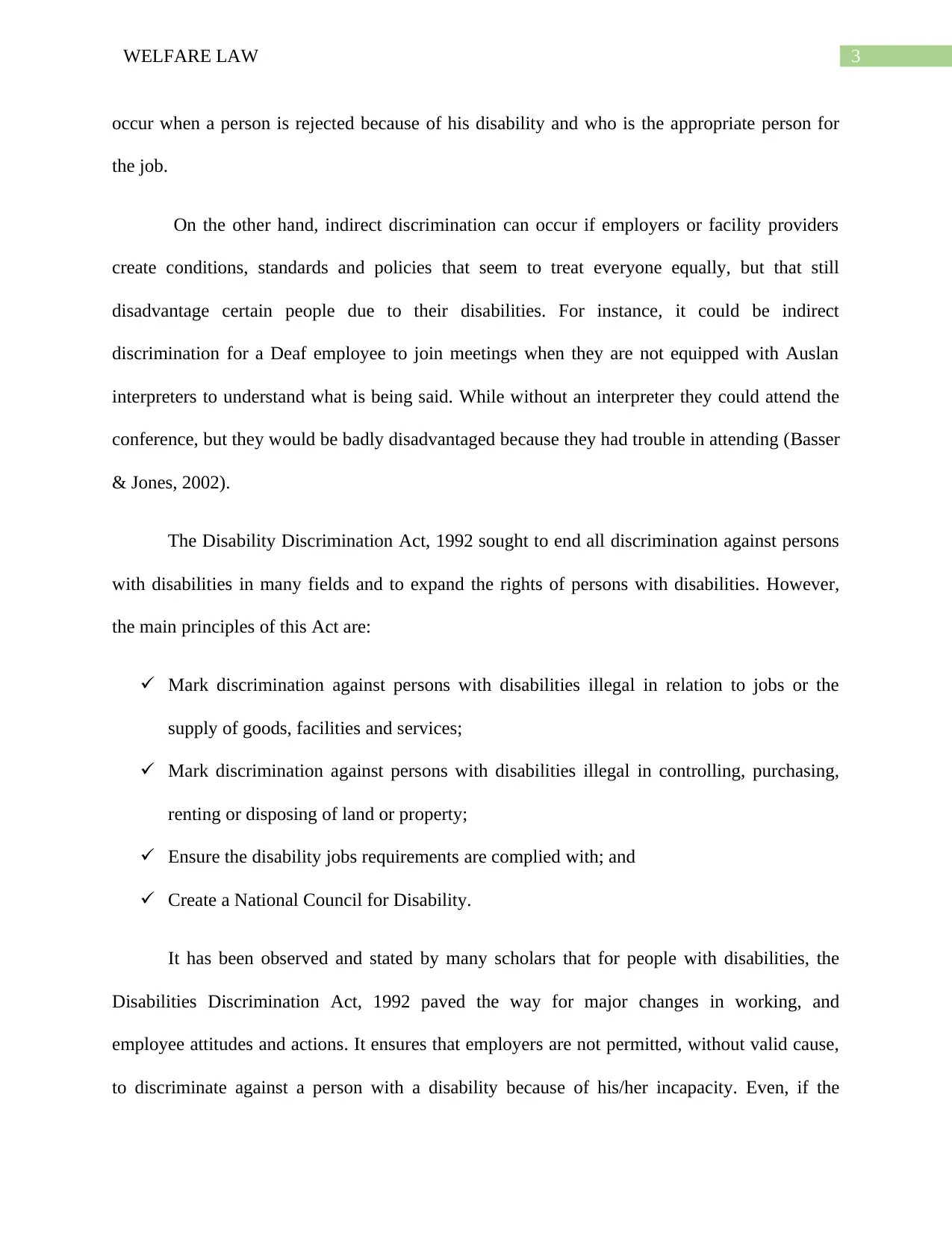
3WELFARE LAW
occur when a person is rejected because of his disability and who is the appropriate person for
the job.
On the other hand, indirect discrimination can occur if employers or facility providers
create conditions, standards and policies that seem to treat everyone equally, but that still
disadvantage certain people due to their disabilities. For instance, it could be indirect
discrimination for a Deaf employee to join meetings when they are not equipped with Auslan
interpreters to understand what is being said. While without an interpreter they could attend the
conference, but they would be badly disadvantaged because they had trouble in attending (Basser
& Jones, 2002).
The Disability Discrimination Act, 1992 sought to end all discrimination against persons
with disabilities in many fields and to expand the rights of persons with disabilities. However,
the main principles of this Act are:
Mark discrimination against persons with disabilities illegal in relation to jobs or the
supply of goods, facilities and services;
Mark discrimination against persons with disabilities illegal in controlling, purchasing,
renting or disposing of land or property;
Ensure the disability jobs requirements are complied with; and
Create a National Council for Disability.
It has been observed and stated by many scholars that for people with disabilities, the
Disabilities Discrimination Act, 1992 paved the way for major changes in working, and
employee attitudes and actions. It ensures that employers are not permitted, without valid cause,
to discriminate against a person with a disability because of his/her incapacity. Even, if the
occur when a person is rejected because of his disability and who is the appropriate person for
the job.
On the other hand, indirect discrimination can occur if employers or facility providers
create conditions, standards and policies that seem to treat everyone equally, but that still
disadvantage certain people due to their disabilities. For instance, it could be indirect
discrimination for a Deaf employee to join meetings when they are not equipped with Auslan
interpreters to understand what is being said. While without an interpreter they could attend the
conference, but they would be badly disadvantaged because they had trouble in attending (Basser
& Jones, 2002).
The Disability Discrimination Act, 1992 sought to end all discrimination against persons
with disabilities in many fields and to expand the rights of persons with disabilities. However,
the main principles of this Act are:
Mark discrimination against persons with disabilities illegal in relation to jobs or the
supply of goods, facilities and services;
Mark discrimination against persons with disabilities illegal in controlling, purchasing,
renting or disposing of land or property;
Ensure the disability jobs requirements are complied with; and
Create a National Council for Disability.
It has been observed and stated by many scholars that for people with disabilities, the
Disabilities Discrimination Act, 1992 paved the way for major changes in working, and
employee attitudes and actions. It ensures that employers are not permitted, without valid cause,
to discriminate against a person with a disability because of his/her incapacity. Even, if the
Paraphrase This Document
Need a fresh take? Get an instant paraphrase of this document with our AI Paraphraser
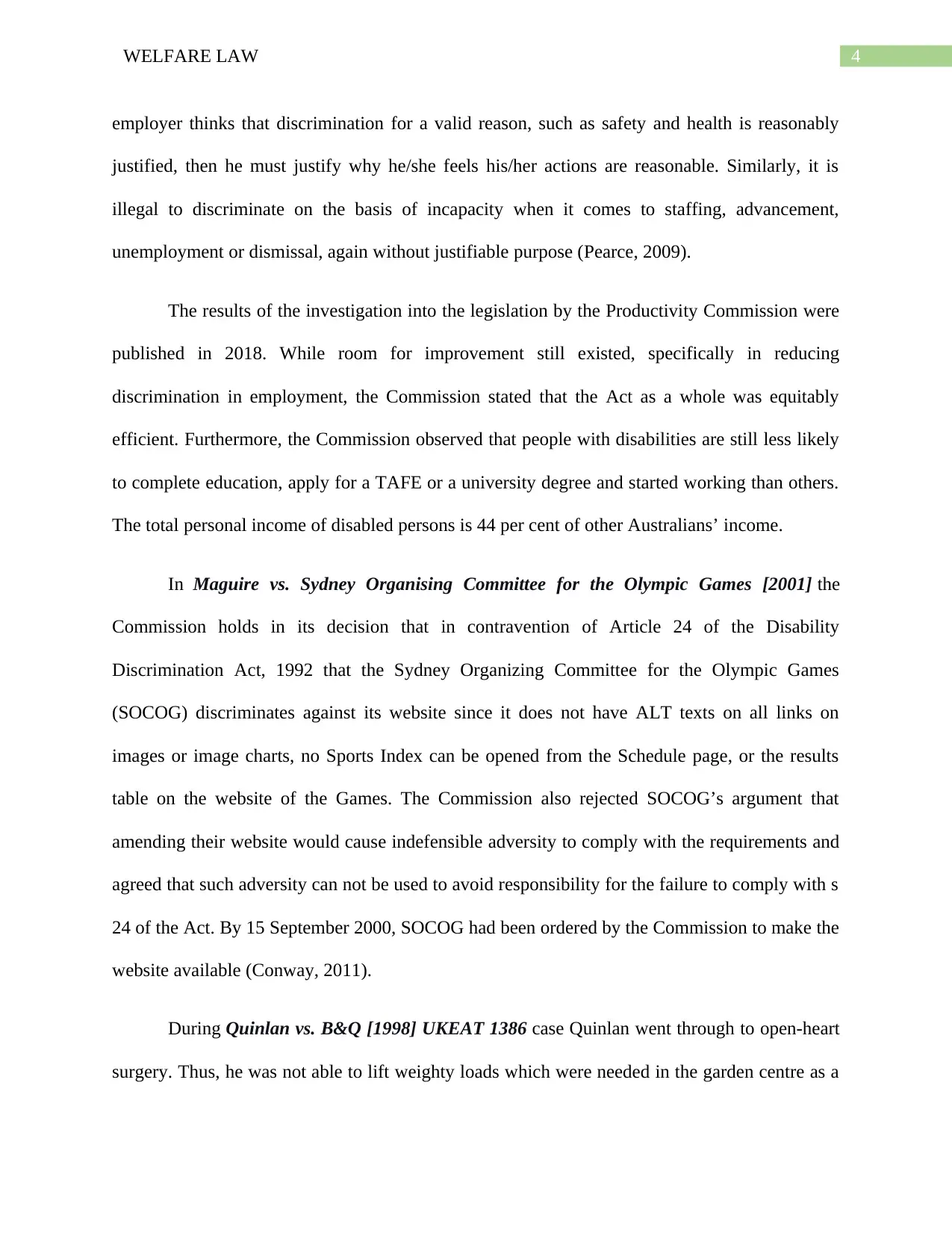
4WELFARE LAW
employer thinks that discrimination for a valid reason, such as safety and health is reasonably
justified, then he must justify why he/she feels his/her actions are reasonable. Similarly, it is
illegal to discriminate on the basis of incapacity when it comes to staffing, advancement,
unemployment or dismissal, again without justifiable purpose (Pearce, 2009).
The results of the investigation into the legislation by the Productivity Commission were
published in 2018. While room for improvement still existed, specifically in reducing
discrimination in employment, the Commission stated that the Act as a whole was equitably
efficient. Furthermore, the Commission observed that people with disabilities are still less likely
to complete education, apply for a TAFE or a university degree and started working than others.
The total personal income of disabled persons is 44 per cent of other Australians’ income.
In Maguire vs. Sydney Organising Committee for the Olympic Games [2001] the
Commission holds in its decision that in contravention of Article 24 of the Disability
Discrimination Act, 1992 that the Sydney Organizing Committee for the Olympic Games
(SOCOG) discriminates against its website since it does not have ALT texts on all links on
images or image charts, no Sports Index can be opened from the Schedule page, or the results
table on the website of the Games. The Commission also rejected SOCOG’s argument that
amending their website would cause indefensible adversity to comply with the requirements and
agreed that such adversity can not be used to avoid responsibility for the failure to comply with s
24 of the Act. By 15 September 2000, SOCOG had been ordered by the Commission to make the
website available (Conway, 2011).
During Quinlan vs. B&Q [1998] UKEAT 1386 case Quinlan went through to open-heart
surgery. Thus, he was not able to lift weighty loads which were needed in the garden centre as a
employer thinks that discrimination for a valid reason, such as safety and health is reasonably
justified, then he must justify why he/she feels his/her actions are reasonable. Similarly, it is
illegal to discriminate on the basis of incapacity when it comes to staffing, advancement,
unemployment or dismissal, again without justifiable purpose (Pearce, 2009).
The results of the investigation into the legislation by the Productivity Commission were
published in 2018. While room for improvement still existed, specifically in reducing
discrimination in employment, the Commission stated that the Act as a whole was equitably
efficient. Furthermore, the Commission observed that people with disabilities are still less likely
to complete education, apply for a TAFE or a university degree and started working than others.
The total personal income of disabled persons is 44 per cent of other Australians’ income.
In Maguire vs. Sydney Organising Committee for the Olympic Games [2001] the
Commission holds in its decision that in contravention of Article 24 of the Disability
Discrimination Act, 1992 that the Sydney Organizing Committee for the Olympic Games
(SOCOG) discriminates against its website since it does not have ALT texts on all links on
images or image charts, no Sports Index can be opened from the Schedule page, or the results
table on the website of the Games. The Commission also rejected SOCOG’s argument that
amending their website would cause indefensible adversity to comply with the requirements and
agreed that such adversity can not be used to avoid responsibility for the failure to comply with s
24 of the Act. By 15 September 2000, SOCOG had been ordered by the Commission to make the
website available (Conway, 2011).
During Quinlan vs. B&Q [1998] UKEAT 1386 case Quinlan went through to open-heart
surgery. Thus, he was not able to lift weighty loads which were needed in the garden centre as a
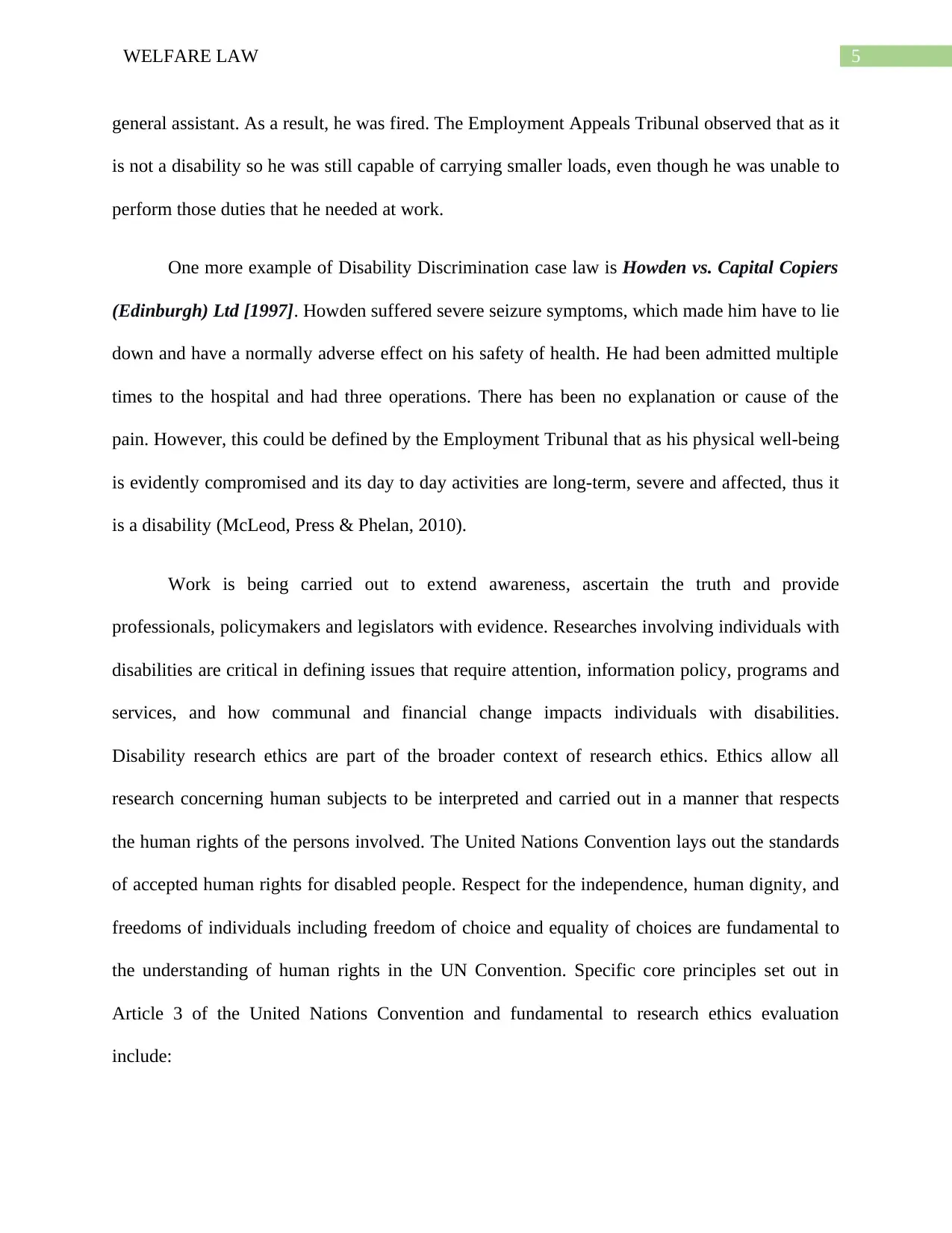
5WELFARE LAW
general assistant. As a result, he was fired. The Employment Appeals Tribunal observed that as it
is not a disability so he was still capable of carrying smaller loads, even though he was unable to
perform those duties that he needed at work.
One more example of Disability Discrimination case law is Howden vs. Capital Copiers
(Edinburgh) Ltd [1997]. Howden suffered severe seizure symptoms, which made him have to lie
down and have a normally adverse effect on his safety of health. He had been admitted multiple
times to the hospital and had three operations. There has been no explanation or cause of the
pain. However, this could be defined by the Employment Tribunal that as his physical well-being
is evidently compromised and its day to day activities are long-term, severe and affected, thus it
is a disability (McLeod, Press & Phelan, 2010).
Work is being carried out to extend awareness, ascertain the truth and provide
professionals, policymakers and legislators with evidence. Researches involving individuals with
disabilities are critical in defining issues that require attention, information policy, programs and
services, and how communal and financial change impacts individuals with disabilities.
Disability research ethics are part of the broader context of research ethics. Ethics allow all
research concerning human subjects to be interpreted and carried out in a manner that respects
the human rights of the persons involved. The United Nations Convention lays out the standards
of accepted human rights for disabled people. Respect for the independence, human dignity, and
freedoms of individuals including freedom of choice and equality of choices are fundamental to
the understanding of human rights in the UN Convention. Specific core principles set out in
Article 3 of the United Nations Convention and fundamental to research ethics evaluation
include:
general assistant. As a result, he was fired. The Employment Appeals Tribunal observed that as it
is not a disability so he was still capable of carrying smaller loads, even though he was unable to
perform those duties that he needed at work.
One more example of Disability Discrimination case law is Howden vs. Capital Copiers
(Edinburgh) Ltd [1997]. Howden suffered severe seizure symptoms, which made him have to lie
down and have a normally adverse effect on his safety of health. He had been admitted multiple
times to the hospital and had three operations. There has been no explanation or cause of the
pain. However, this could be defined by the Employment Tribunal that as his physical well-being
is evidently compromised and its day to day activities are long-term, severe and affected, thus it
is a disability (McLeod, Press & Phelan, 2010).
Work is being carried out to extend awareness, ascertain the truth and provide
professionals, policymakers and legislators with evidence. Researches involving individuals with
disabilities are critical in defining issues that require attention, information policy, programs and
services, and how communal and financial change impacts individuals with disabilities.
Disability research ethics are part of the broader context of research ethics. Ethics allow all
research concerning human subjects to be interpreted and carried out in a manner that respects
the human rights of the persons involved. The United Nations Convention lays out the standards
of accepted human rights for disabled people. Respect for the independence, human dignity, and
freedoms of individuals including freedom of choice and equality of choices are fundamental to
the understanding of human rights in the UN Convention. Specific core principles set out in
Article 3 of the United Nations Convention and fundamental to research ethics evaluation
include:
⊘ This is a preview!⊘
Do you want full access?
Subscribe today to unlock all pages.

Trusted by 1+ million students worldwide
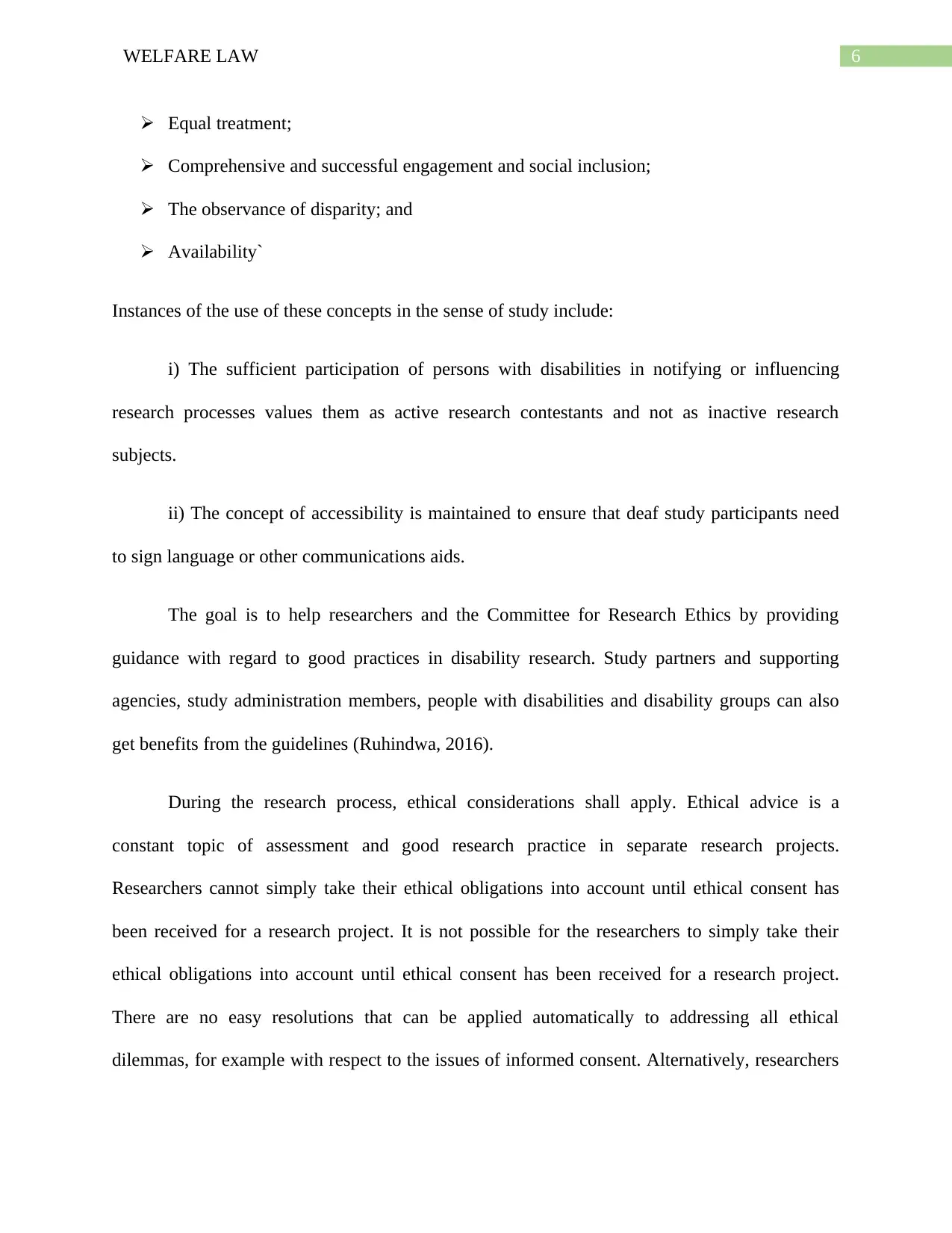
6WELFARE LAW
Equal treatment;
Comprehensive and successful engagement and social inclusion;
The observance of disparity; and
Availability`
Instances of the use of these concepts in the sense of study include:
i) The sufficient participation of persons with disabilities in notifying or influencing
research processes values them as active research contestants and not as inactive research
subjects.
ii) The concept of accessibility is maintained to ensure that deaf study participants need
to sign language or other communications aids.
The goal is to help researchers and the Committee for Research Ethics by providing
guidance with regard to good practices in disability research. Study partners and supporting
agencies, study administration members, people with disabilities and disability groups can also
get benefits from the guidelines (Ruhindwa, 2016).
During the research process, ethical considerations shall apply. Ethical advice is a
constant topic of assessment and good research practice in separate research projects.
Researchers cannot simply take their ethical obligations into account until ethical consent has
been received for a research project. It is not possible for the researchers to simply take their
ethical obligations into account until ethical consent has been received for a research project.
There are no easy resolutions that can be applied automatically to addressing all ethical
dilemmas, for example with respect to the issues of informed consent. Alternatively, researchers
Equal treatment;
Comprehensive and successful engagement and social inclusion;
The observance of disparity; and
Availability`
Instances of the use of these concepts in the sense of study include:
i) The sufficient participation of persons with disabilities in notifying or influencing
research processes values them as active research contestants and not as inactive research
subjects.
ii) The concept of accessibility is maintained to ensure that deaf study participants need
to sign language or other communications aids.
The goal is to help researchers and the Committee for Research Ethics by providing
guidance with regard to good practices in disability research. Study partners and supporting
agencies, study administration members, people with disabilities and disability groups can also
get benefits from the guidelines (Ruhindwa, 2016).
During the research process, ethical considerations shall apply. Ethical advice is a
constant topic of assessment and good research practice in separate research projects.
Researchers cannot simply take their ethical obligations into account until ethical consent has
been received for a research project. It is not possible for the researchers to simply take their
ethical obligations into account until ethical consent has been received for a research project.
There are no easy resolutions that can be applied automatically to addressing all ethical
dilemmas, for example with respect to the issues of informed consent. Alternatively, researchers
Paraphrase This Document
Need a fresh take? Get an instant paraphrase of this document with our AI Paraphraser
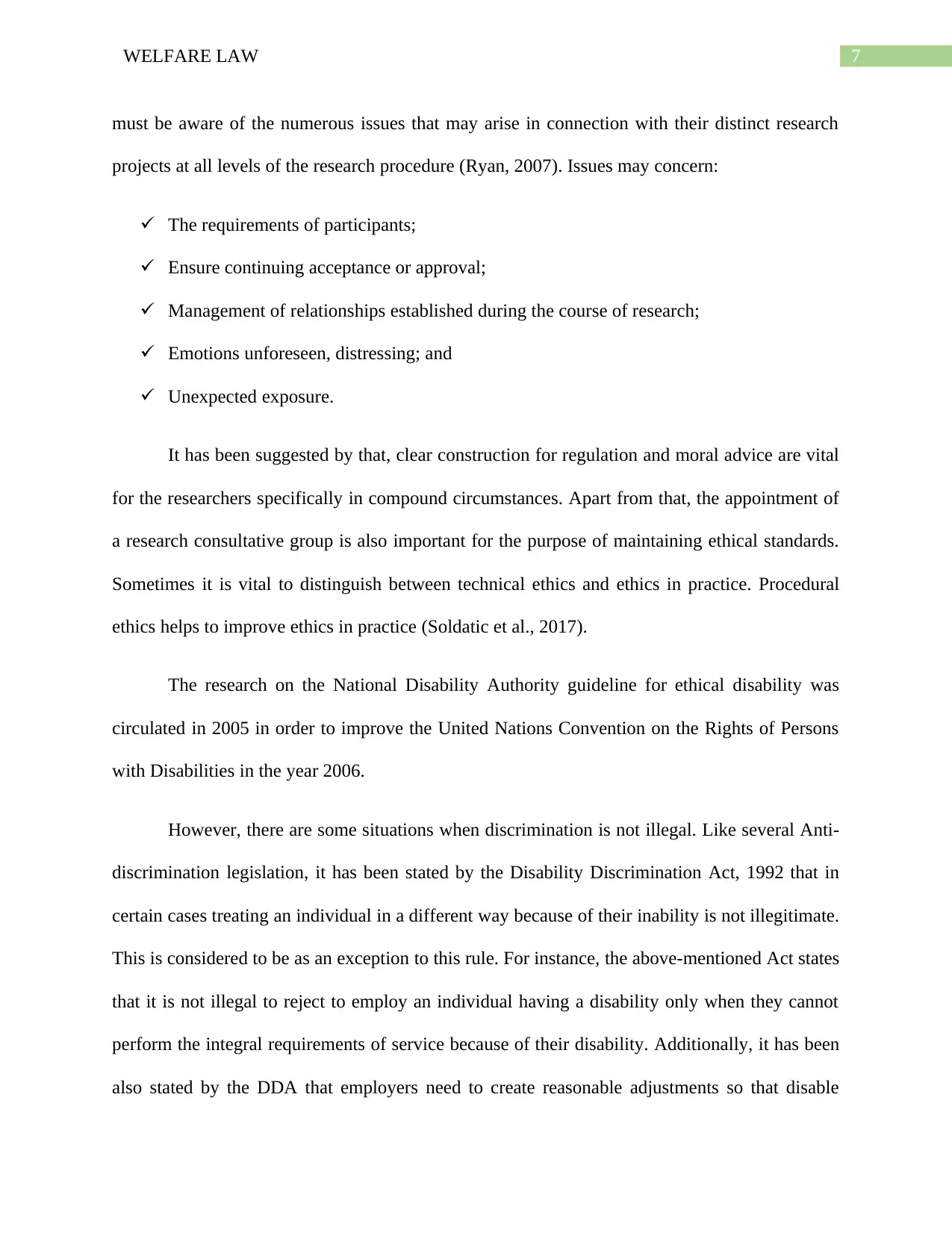
7WELFARE LAW
must be aware of the numerous issues that may arise in connection with their distinct research
projects at all levels of the research procedure (Ryan, 2007). Issues may concern:
The requirements of participants;
Ensure continuing acceptance or approval;
Management of relationships established during the course of research;
Emotions unforeseen, distressing; and
Unexpected exposure.
It has been suggested by that, clear construction for regulation and moral advice are vital
for the researchers specifically in compound circumstances. Apart from that, the appointment of
a research consultative group is also important for the purpose of maintaining ethical standards.
Sometimes it is vital to distinguish between technical ethics and ethics in practice. Procedural
ethics helps to improve ethics in practice (Soldatic et al., 2017).
The research on the National Disability Authority guideline for ethical disability was
circulated in 2005 in order to improve the United Nations Convention on the Rights of Persons
with Disabilities in the year 2006.
However, there are some situations when discrimination is not illegal. Like several Anti-
discrimination legislation, it has been stated by the Disability Discrimination Act, 1992 that in
certain cases treating an individual in a different way because of their inability is not illegitimate.
This is considered to be as an exception to this rule. For instance, the above-mentioned Act states
that it is not illegal to reject to employ an individual having a disability only when they cannot
perform the integral requirements of service because of their disability. Additionally, it has been
also stated by the DDA that employers need to create reasonable adjustments so that disable
must be aware of the numerous issues that may arise in connection with their distinct research
projects at all levels of the research procedure (Ryan, 2007). Issues may concern:
The requirements of participants;
Ensure continuing acceptance or approval;
Management of relationships established during the course of research;
Emotions unforeseen, distressing; and
Unexpected exposure.
It has been suggested by that, clear construction for regulation and moral advice are vital
for the researchers specifically in compound circumstances. Apart from that, the appointment of
a research consultative group is also important for the purpose of maintaining ethical standards.
Sometimes it is vital to distinguish between technical ethics and ethics in practice. Procedural
ethics helps to improve ethics in practice (Soldatic et al., 2017).
The research on the National Disability Authority guideline for ethical disability was
circulated in 2005 in order to improve the United Nations Convention on the Rights of Persons
with Disabilities in the year 2006.
However, there are some situations when discrimination is not illegal. Like several Anti-
discrimination legislation, it has been stated by the Disability Discrimination Act, 1992 that in
certain cases treating an individual in a different way because of their inability is not illegitimate.
This is considered to be as an exception to this rule. For instance, the above-mentioned Act states
that it is not illegal to reject to employ an individual having a disability only when they cannot
perform the integral requirements of service because of their disability. Additionally, it has been
also stated by the DDA that employers need to create reasonable adjustments so that disable
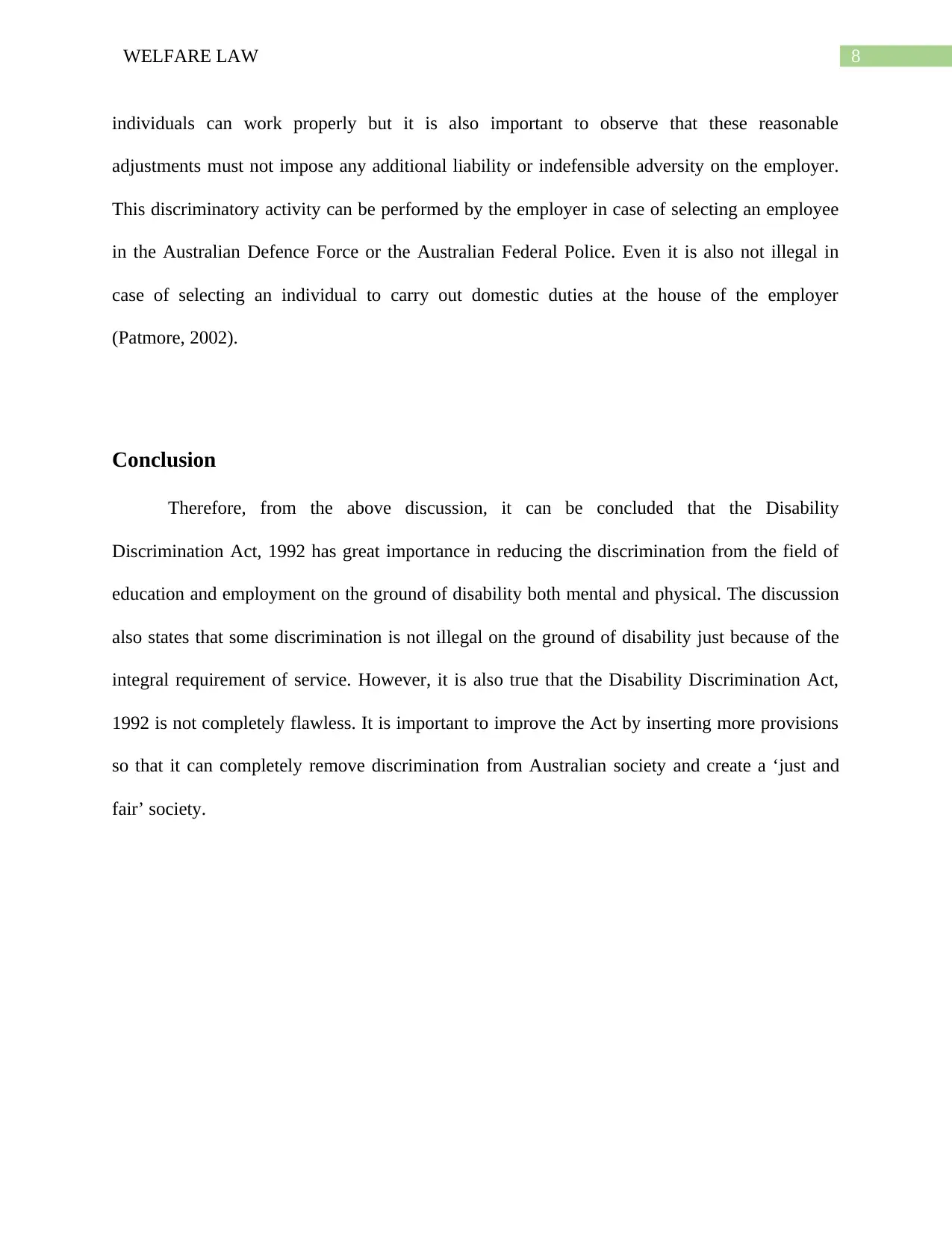
8WELFARE LAW
individuals can work properly but it is also important to observe that these reasonable
adjustments must not impose any additional liability or indefensible adversity on the employer.
This discriminatory activity can be performed by the employer in case of selecting an employee
in the Australian Defence Force or the Australian Federal Police. Even it is also not illegal in
case of selecting an individual to carry out domestic duties at the house of the employer
(Patmore, 2002).
Conclusion
Therefore, from the above discussion, it can be concluded that the Disability
Discrimination Act, 1992 has great importance in reducing the discrimination from the field of
education and employment on the ground of disability both mental and physical. The discussion
also states that some discrimination is not illegal on the ground of disability just because of the
integral requirement of service. However, it is also true that the Disability Discrimination Act,
1992 is not completely flawless. It is important to improve the Act by inserting more provisions
so that it can completely remove discrimination from Australian society and create a ‘just and
fair’ society.
individuals can work properly but it is also important to observe that these reasonable
adjustments must not impose any additional liability or indefensible adversity on the employer.
This discriminatory activity can be performed by the employer in case of selecting an employee
in the Australian Defence Force or the Australian Federal Police. Even it is also not illegal in
case of selecting an individual to carry out domestic duties at the house of the employer
(Patmore, 2002).
Conclusion
Therefore, from the above discussion, it can be concluded that the Disability
Discrimination Act, 1992 has great importance in reducing the discrimination from the field of
education and employment on the ground of disability both mental and physical. The discussion
also states that some discrimination is not illegal on the ground of disability just because of the
integral requirement of service. However, it is also true that the Disability Discrimination Act,
1992 is not completely flawless. It is important to improve the Act by inserting more provisions
so that it can completely remove discrimination from Australian society and create a ‘just and
fair’ society.
⊘ This is a preview!⊘
Do you want full access?
Subscribe today to unlock all pages.

Trusted by 1+ million students worldwide
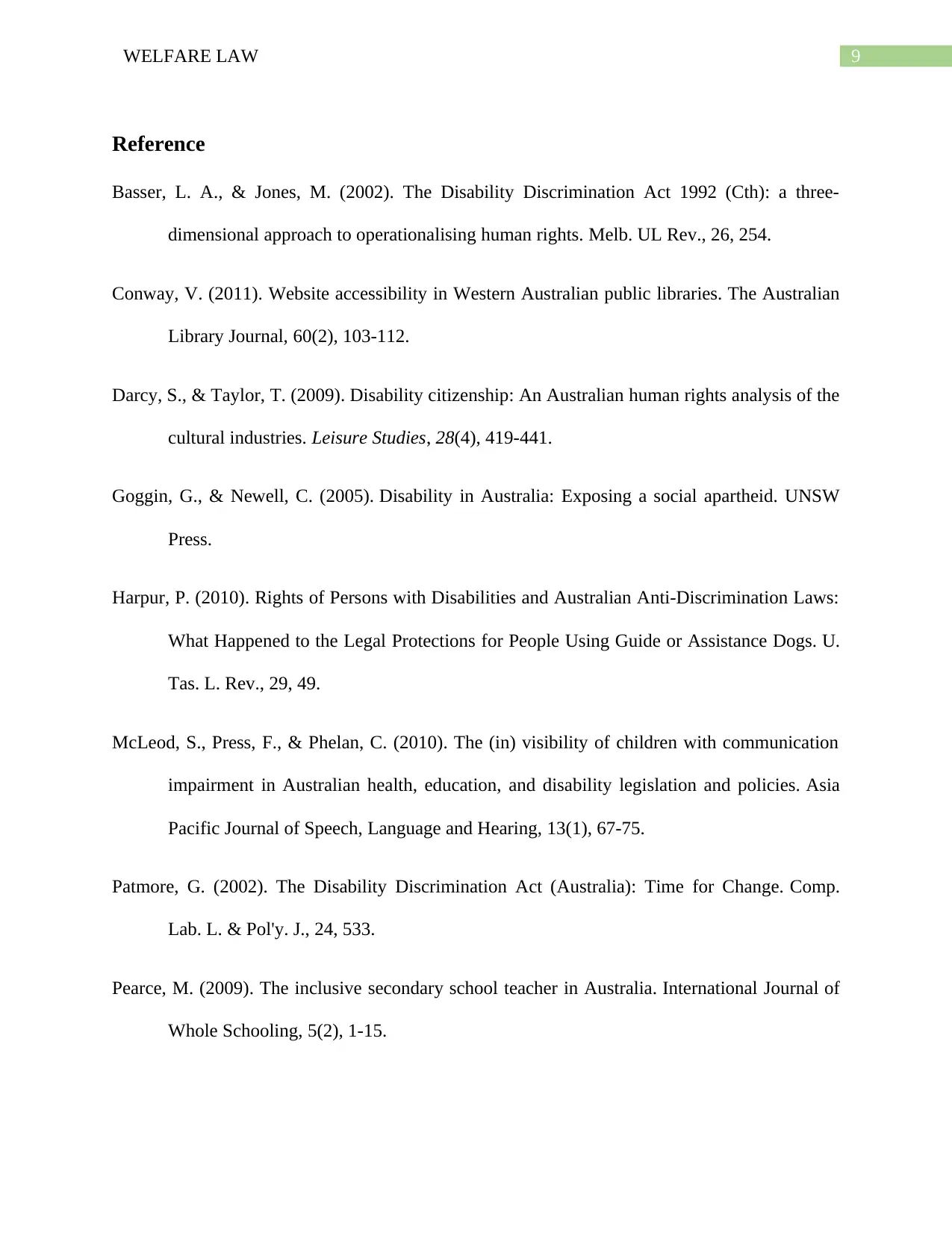
9WELFARE LAW
Reference
Basser, L. A., & Jones, M. (2002). The Disability Discrimination Act 1992 (Cth): a three-
dimensional approach to operationalising human rights. Melb. UL Rev., 26, 254.
Conway, V. (2011). Website accessibility in Western Australian public libraries. The Australian
Library Journal, 60(2), 103-112.
Darcy, S., & Taylor, T. (2009). Disability citizenship: An Australian human rights analysis of the
cultural industries. Leisure Studies, 28(4), 419-441.
Goggin, G., & Newell, C. (2005). Disability in Australia: Exposing a social apartheid. UNSW
Press.
Harpur, P. (2010). Rights of Persons with Disabilities and Australian Anti-Discrimination Laws:
What Happened to the Legal Protections for People Using Guide or Assistance Dogs. U.
Tas. L. Rev., 29, 49.
McLeod, S., Press, F., & Phelan, C. (2010). The (in) visibility of children with communication
impairment in Australian health, education, and disability legislation and policies. Asia
Pacific Journal of Speech, Language and Hearing, 13(1), 67-75.
Patmore, G. (2002). The Disability Discrimination Act (Australia): Time for Change. Comp.
Lab. L. & Pol'y. J., 24, 533.
Pearce, M. (2009). The inclusive secondary school teacher in Australia. International Journal of
Whole Schooling, 5(2), 1-15.
Reference
Basser, L. A., & Jones, M. (2002). The Disability Discrimination Act 1992 (Cth): a three-
dimensional approach to operationalising human rights. Melb. UL Rev., 26, 254.
Conway, V. (2011). Website accessibility in Western Australian public libraries. The Australian
Library Journal, 60(2), 103-112.
Darcy, S., & Taylor, T. (2009). Disability citizenship: An Australian human rights analysis of the
cultural industries. Leisure Studies, 28(4), 419-441.
Goggin, G., & Newell, C. (2005). Disability in Australia: Exposing a social apartheid. UNSW
Press.
Harpur, P. (2010). Rights of Persons with Disabilities and Australian Anti-Discrimination Laws:
What Happened to the Legal Protections for People Using Guide or Assistance Dogs. U.
Tas. L. Rev., 29, 49.
McLeod, S., Press, F., & Phelan, C. (2010). The (in) visibility of children with communication
impairment in Australian health, education, and disability legislation and policies. Asia
Pacific Journal of Speech, Language and Hearing, 13(1), 67-75.
Patmore, G. (2002). The Disability Discrimination Act (Australia): Time for Change. Comp.
Lab. L. & Pol'y. J., 24, 533.
Pearce, M. (2009). The inclusive secondary school teacher in Australia. International Journal of
Whole Schooling, 5(2), 1-15.
Paraphrase This Document
Need a fresh take? Get an instant paraphrase of this document with our AI Paraphraser
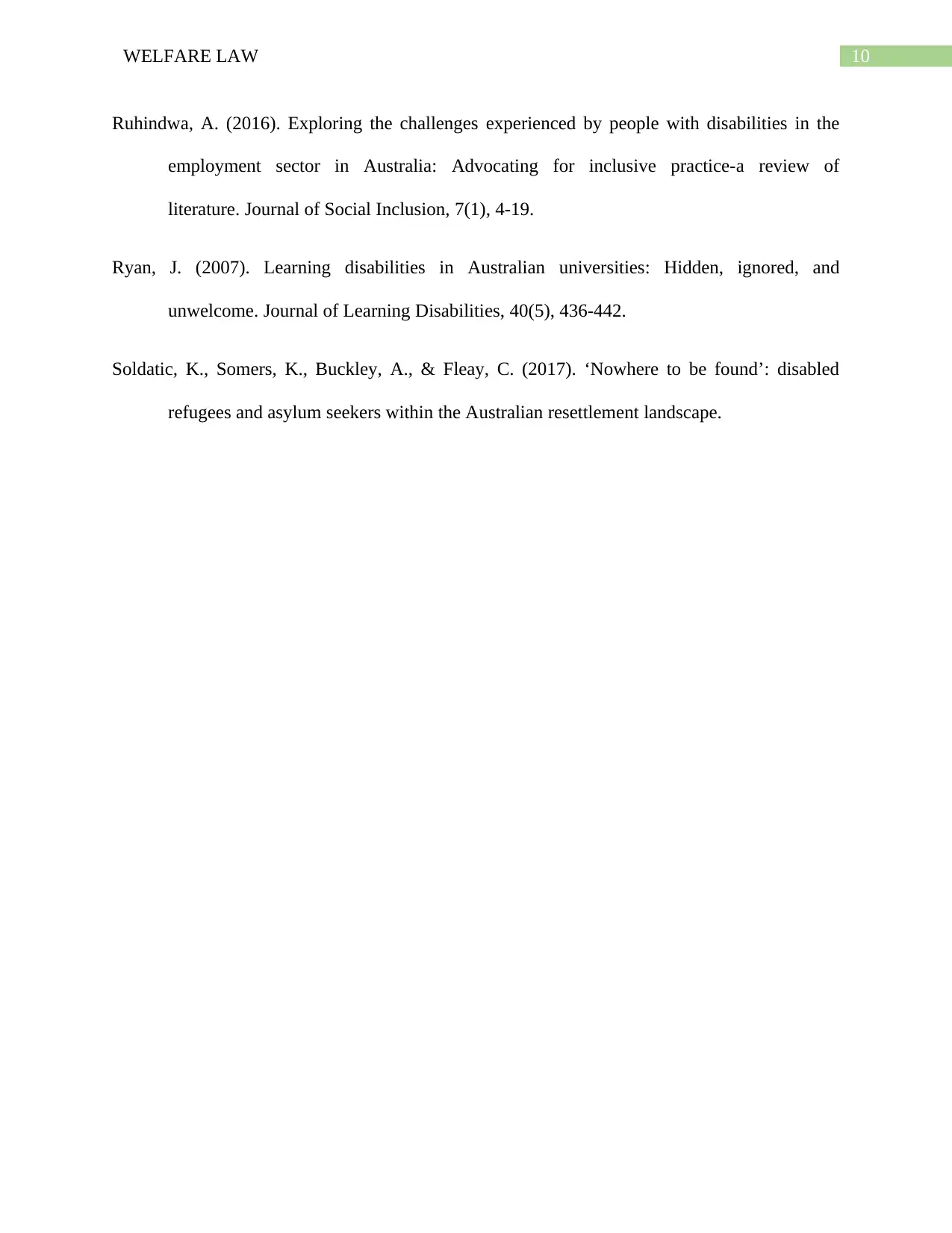
10WELFARE LAW
Ruhindwa, A. (2016). Exploring the challenges experienced by people with disabilities in the
employment sector in Australia: Advocating for inclusive practice-a review of
literature. Journal of Social Inclusion, 7(1), 4-19.
Ryan, J. (2007). Learning disabilities in Australian universities: Hidden, ignored, and
unwelcome. Journal of Learning Disabilities, 40(5), 436-442.
Soldatic, K., Somers, K., Buckley, A., & Fleay, C. (2017). ‘Nowhere to be found’: disabled
refugees and asylum seekers within the Australian resettlement landscape.
Ruhindwa, A. (2016). Exploring the challenges experienced by people with disabilities in the
employment sector in Australia: Advocating for inclusive practice-a review of
literature. Journal of Social Inclusion, 7(1), 4-19.
Ryan, J. (2007). Learning disabilities in Australian universities: Hidden, ignored, and
unwelcome. Journal of Learning Disabilities, 40(5), 436-442.
Soldatic, K., Somers, K., Buckley, A., & Fleay, C. (2017). ‘Nowhere to be found’: disabled
refugees and asylum seekers within the Australian resettlement landscape.
1 out of 11
Related Documents
Your All-in-One AI-Powered Toolkit for Academic Success.
+13062052269
info@desklib.com
Available 24*7 on WhatsApp / Email
![[object Object]](/_next/static/media/star-bottom.7253800d.svg)
Unlock your academic potential
Copyright © 2020–2025 A2Z Services. All Rights Reserved. Developed and managed by ZUCOL.





